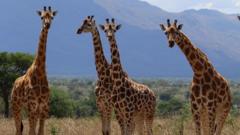Giraffes, long revered as iconic inhabitants of the African savannah, have been officially categorized into four distinct species, according to recent findings by the International Union for Conservation of Nature (IUCN). This revelation has sparked excitement within the scientific community and raises important questions about conservation approaches for these graceful giants.
The four identified species include the Southern giraffe, found in regions such as Namibia and southern Botswana; the Reticulated giraffe, which roams the grassy landscapes of Kenya, Somalia, and Ethiopia; the Northern giraffe located in parts of Uganda and South Sudan; and the uniquely patterned Masai giraffe, native to Kenya and Tanzania. Each species has evolved under different environmental pressures and geographical separations, which were illuminated through studies of skull sizes and genetic diversity.
Researchers utilized historical data on natural barriers, like rivers and mountains, that have likely influenced the evolution of giraffe populations across Africa. The Southern giraffe, for example, is believed to have diverged due to natural features like the Kunene and Zambezi rivers, while the Reticulated giraffe was separated by Ethiopia's rugged terrain. Similarly, the Northern giraffe's populations are distinct due to the migration patterns shaped by the Nile River and Lake Victoria.
IUCN co-author Michael Brown emphasized the importance of accurately understanding giraffe taxonomy, stating, "The more precisely we understand giraffe taxonomy, the better equipped we are to assess their status and implement effective conservation strategies." Previously categorized as a single vulnerable species, the new classification allows for a more nuanced understanding of the threats these new species face.
With this newfound knowledge, conservationists aim to reassess the vulnerability of the newly identified giraffe species to develop tailored strategies for the preservation of their populations. This advancement is pivotal, as it contributes to ongoing efforts to safeguard one of nature's most beloved mammals from extinction, while fostering an improved understanding of the ecological and genetic diversity within giraffe populations.
The four identified species include the Southern giraffe, found in regions such as Namibia and southern Botswana; the Reticulated giraffe, which roams the grassy landscapes of Kenya, Somalia, and Ethiopia; the Northern giraffe located in parts of Uganda and South Sudan; and the uniquely patterned Masai giraffe, native to Kenya and Tanzania. Each species has evolved under different environmental pressures and geographical separations, which were illuminated through studies of skull sizes and genetic diversity.
Researchers utilized historical data on natural barriers, like rivers and mountains, that have likely influenced the evolution of giraffe populations across Africa. The Southern giraffe, for example, is believed to have diverged due to natural features like the Kunene and Zambezi rivers, while the Reticulated giraffe was separated by Ethiopia's rugged terrain. Similarly, the Northern giraffe's populations are distinct due to the migration patterns shaped by the Nile River and Lake Victoria.
IUCN co-author Michael Brown emphasized the importance of accurately understanding giraffe taxonomy, stating, "The more precisely we understand giraffe taxonomy, the better equipped we are to assess their status and implement effective conservation strategies." Previously categorized as a single vulnerable species, the new classification allows for a more nuanced understanding of the threats these new species face.
With this newfound knowledge, conservationists aim to reassess the vulnerability of the newly identified giraffe species to develop tailored strategies for the preservation of their populations. This advancement is pivotal, as it contributes to ongoing efforts to safeguard one of nature's most beloved mammals from extinction, while fostering an improved understanding of the ecological and genetic diversity within giraffe populations.























